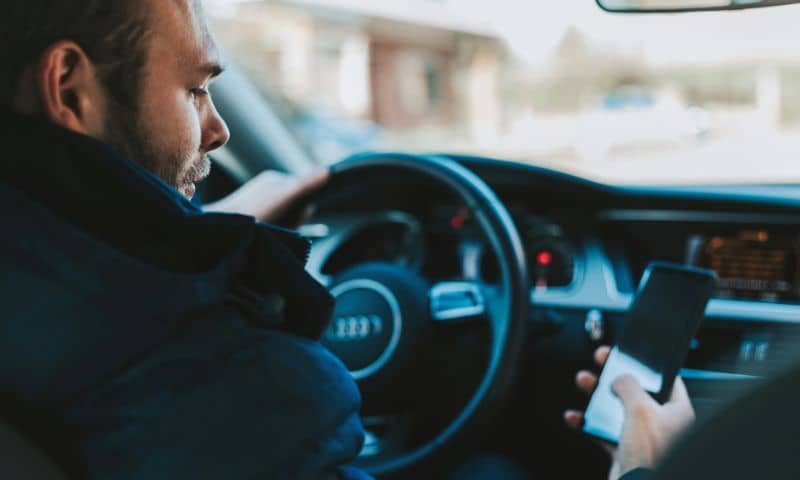
Top 8 Examples of Distracted Driving and What to Do If You’re in an Accident
Distracted driving has become a big problem on West Virginia roads and across the United States, causing countless accidents and personal injuries each year. So, what exactly is distracted driving?
Put simply, it’s any activity that diverts your attention away from the task of operating a vehicle safely. According to the National Highway Traffic Safety Administration (NHTSA), distracted driving claimed 3,142 lives in 2020 alone.
As a driver, you must understand the risks associated with negligent vehicle operation and take steps to avoid them. Let’s look at eight common examples of distracted driving and their dangers.
1. Texting While Driving: A Recipe for Disaster
Texting while driving is perhaps the most well-known form of distracted driving – and for a good reason. When you take your eyes off the road to read or send a text message, you’re driving blind. In fact, the NHTSA reports that sending or reading a text takes your eyes off the road for five seconds. At 55 mph, that’s like driving the length of a football field with your eyes closed.
West Virginia law prohibits texting while driving for all vehicle operators. You could face fines and points on your license if caught doing this negligent act.
Using Social Media Apps Is Just as Dangerous
While texting is the most well-known form of distracted driving, using social media apps while behind the wheel poses similar risks. Just like with texting, engaging with phone apps takes your eyes off the road and your mind off the task of driving.
Hands-Free Phone Conversations Aren’t Risk-Free
Many drivers believe that using a hands-free device to talk on the phone while driving is a safe alternative to holding the phone. However, research has shown that even hands-free phone conversations can be cognitively distracting, taking your mind off the road and increasing your risk of an accident.
In West Virginia, using a handheld cell phone while driving is illegal, but hands-free devices are permitted. However, just because it’s legal doesn’t mean it’s safe. If you need to take a call while driving, it’s best to pull over to a secure location first.
Checking Notifications or Alerts
We’ve all been there – you’re driving when your phone suddenly pings with a new notification. It’s tempting to glance down and see what it is, but even a brief distraction can lead to an accident.
2. Eating or Drinking: A Manual and Cognitive Distraction
While it can seem harmless, eating and drinking while driving can become a significant distraction. When you’re handling food or beverage containers, you’re taking one or both hands off the wheel, reducing your ability to react quickly to changes in traffic. Additionally, focusing on eating or drinking takes your mind off the task of driving, increasing your risk of an accident.
Spills or dropped items can further compound the distraction, causing you to take your eyes off the road as you attempt to clean up the mess. To stay safe, eat and drink before driving or pull over if you need a snack break.
3. Applying Makeup or Grooming
Some of us have witnessed a driver next to us applying mascara or fixing their hair at a stoplight. While it may seem like a time-saver to squeeze in some personal grooming while behind the wheel, it’s a risky habit that can lead to accidents and injuries. Applying makeup or grooming means taking your eyes off the road and your hands off the wheel, significantly increasing crash risk.
4. Adjusting Vehicle Controls
Messing with your radio, climate control, or GPS may seem harmless, but it can be a significant source of manual and cognitive distraction while driving. When you reach for knobs or buttons on your dashboard, at least one hand comes off the wheel, reducing your ability to steer and focus on traffic.
Familiarize yourself with your vehicle’s controls before hitting the road to minimize the risk of distraction. Set your gadgets before driving, and avoid making adjustments while in motion. If you need to change something, wait until you’re stopped at a red light or pull over to a safe location.
5. Reaching for Fallen Objects: Tempting but Dangerous Moves
So, you’re driving along when suddenly your phone, wallet, or other important item falls to the floor of your car. It’s tempting to reach down and grab it, but doing so takes your eyes off the road and your hands off the wheel, significantly increasing your risk of an accident.
Instead of reaching for fallen objects while driving, wait to retrieve them later. It may be inconvenient, but it’s far better than causing a crash and potentially injuring yourself or others.
6. Interacting with Passengers
Driving with passengers can be a great way to pass the time on a long trip or commute, but it can also be a significant source of distraction. Conversations with passengers take your mind off driving, even when your eyes are still on the road.
From crying babies to anxious dogs, these potential distractions may take your attention away from the road. Secure children and pets properly before starting the vehicle to minimize the distraction risks. Install car seats correctly and restrain your pets safely in a crate or harness.
Resist the urge to turn around or reach into the backseat when something requires attention. Or better yet, pull over to a safe location to address the issue.
7. Daydreaming or Zoning Out
Not all forms of distracted driving involve taking your hands off the wheel or your eyes off the road. Daydreaming or zoning out can be just as dangerous, as it takes your mind off vehicle operation and reduces your ability to react to traffic changes.
When you’re mentally distracted, you may miss important traffic signals, signs, or changes in road conditions, increasing your risk of an accident.
Frequently daydreaming or zoning out behind the wheel may indicate you’re too tired to drive safely. Pull over to a safe location to rest or switch drivers when possible.
8. Rubbernecking or Staring at Roadside Incidents
We’ve all experienced the morbid curiosity of passing an accident. It’s natural to want to slow down and take a look, but doing so can be a significant visual distraction.
When you focus on a roadside incident, you’re taking your eyes off the road ahead and your mind off the task of driving. This act can lead to additional accidents and injuries, as rubbernecking drivers may fail to notice slowing or stopping traffic ahead of them.
What to Do If You’re in an Accident Caused by Distracted Driving
If you’ve been in an accident with a distracted driver, stay calm and take the proper steps to protect yourself and your right to compensation.
- Move to a Safe Area: If possible, drive your vehicle to the side of the road or a nearby parking lot. If your vehicle is not drivable, turn on your hazard lights and get yourself and any passengers to a safe area away from traffic.
- Call Emergency Services: Once you’re out of harm’s way, call 911 to report the accident and request medical assistance if anyone is injured.
- Document the Scene: Use your smartphone to take photos and videos of the accident scene, the vehicle damage, road conditions, and any visible injuries. These will serve as important evidence.
- Exchange Information: Get the name, contact details, driver’s license number, license plate, and insurance information from the other driver(s) involved.
- Obtain Witness Contacts: If there were any eyewitnesses to the accident, try to get their names and contact information as well.
- File a Police Report: When the police arrive, provide them with an accurate account of what happened, including details about the other driver’s distracted behavior that caused the accident.
- Seek Medical Attention: Even if you feel fine, it’s wise to get checked out by a doctor, as some injuries may not be immediately apparent.
- Contact Your Insurance Company: Notify your insurance provider about the accident as soon as possible and follow their procedures for filing a claim.
By taking these steps, you’ll help build a strong case and increase your chances of receiving fair compensation if the other driver was at fault due to distracted driving.
Can You Sue for a Distracted Driving Accident?
Yes, if you are involved in an accident caused by another driver’s distracted behavior, such as texting, eating, or any other activity that took their attention away from the road, you may be able to claim damages.
Distracted driving is considered negligent behavior that violates the duty of care that all drivers owe to others on the road. By failing to give driving their full attention, the distracted driver has breached that duty.
If the distracted driver’s negligence directly caused your accident and resulting injuries or property damage, you can potentially file a personal injury claim or lawsuit against them to recover compensation for:
- Medical expenses
- Lost wages
- Property damage
- Pain and suffering
- Other accident-related costs
Having evidence like photos/videos of the scene, witness statements about the distracted behavior, and an official police report documenting distraction as the cause will strengthen your case. An experienced personal injury lawyer can assess the details and guide you through seeking compensation.
At Miley Legal in West Virginia, our injury law firm offers free consultations where you can discuss your concerns and learn more about your legal options. By working together to raise awareness about the risks of distracted driving and holding distracted drivers accountable for their actions, we can make West Virginia roads safer for everyone.

